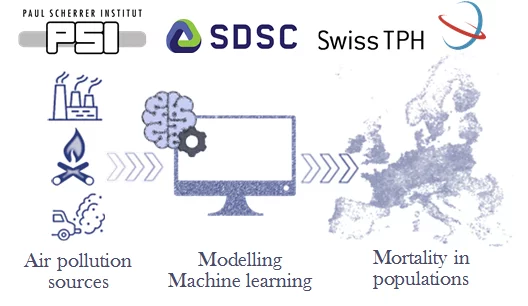The Laboratory of Atmospheric Chemistry has initiated innovative data-science-based modelling approaches to discover the most important pollution sources for human health.
Air pollution kills around 10 million person every year. It classifies today among the five leading causes of premature deaths worldwide, alongside with high blood pressure, smoking, diabetes and obesity. The polluted air we breathe contains high levels of particulate matter (PM), tiny solid and liquid particles suspended in the air with diameters ranging from few nanometers to few tens of micrometers. This year, the world health organization (WHO) has released their new guidelines for fine PM annual concentrations, proposing much more stringent limit values as low as 5 μg m-3. These values are currently only found in remote environments, while 99% of the world population lives in places where these levels are never met. This is effectively the ‘Net-Zero’s’ equivalent for PM emissions and air quality. Switzerland has heavily invested for over 30 years to meet just now the former WHO limit of 10 μg m-3. Meanwhile, PM annual levels greater than 50 μg m-3 are still very common in low- to middle-income countries, e.g. in China or India, where 90% of PM-related deaths occur. These numbers correspond to ~6 years of life expectancy lost to pollution in Asia, compared to several months in Western Europe. The knowledge of the most significant PM sources for human health is vitally important for reducing PM-related premature deaths.
The association between PM exposure and the probability of death is based on the total PM mass, while PM’s health effects are strongly mediated by its chemical composition and size, and hence its origin. In cities, PM composition and levels can vary sharply over short distances owing to unevenly distributed emissions, dilution, and chemical transformations. Such gradients have important consequences for the assessment of personalized exposures. Thus, epidemiological analyses relating PM sources to health outcomes in populations require the determination of high-resolution maps of source-specific PM concentrations over large scales, which currently no technique can provide. To address this gap, the Laboratory of Atmospheric Chemistry (LAC) has now initiated a large interdisciplinary collaboration between atmospheric scientists and numerical modelers from PSI, epidemiologists and medical scientists from the Swiss Tropical and Public Health institute (TPH) and the Swiss Data Science Center (SDSC). This is within the new project AURORA (from Air pollUtion souRces tO moRtAlity), funded by the SDSC and the Federal Office for the Environment (FOEN). Aurora proposes a machine-learning-based modelling framework that integrates geo-statistical data and atmospheric modelling to provide 4D maps of PM pollution from different sources with an unprecedented combination of spatial and temporal coverage and resolution required for human exposure assessments. Resulting maps will be combined with 30 year records of mortality data to determine the most important PM sources for health.
AURORA will focus on the total PM-related-deaths in Switzerland, while opening entirely new avenues of research and innovation at the LAC for the next 10 years. Our scalable modelling approach could readily address major air quality data gaps in other locations in the world, e.g. in Eastern Europe, India and China, complementing our concerted field measurement efforts in these regions. The LAC is uniquely positioned worldwide for achieving these goals because of our capabilities in combining field observations and modelling and our strong networks of collaborators in different regions. Meanwhile, PM can enter our body through various routes, e.g. nasal-to-brain route, lung deposition or ingestion, affecting us through multiple complex biological pathways, depending on its size and chemical composition. As a result, PM has numerous health effects, including cardiovascular diseases, respiratory symptoms, cancer, diabetes, and neurodegenerative diseases. Modelling outputs could be used to interrogate the association between different PM sources and each of these health outcomes. Enabled by the rapid advances in omics, genetics, imaging, and digital healthcare data (e.g. on smart phone applications) and our strong connections to medical and health institutes, we will also be able to further elucidate the biological pathways involved in the different PM health effects.
More broadly, the availability of high-resolution air quality data down to specific pollution sources could have transformative implications for environmental management, air pollution science, epidemiology, public awareness, and policy. AURORA’s model will enable the identification of key sources controlling PM health impacts, and their sensitivity to changes in energy- and land-use that cities are currently experiencing. The modeling framework will allow policy makers to optimize emission reduction strategies and sustainable urban planning. This can include the application of targeted measures for limiting the most important PM sources for health or the design of land-use and built environments for better air quality. In turn, as local variation in air pollution sources profoundly impacts public health and environmental equity, AURORA’s results will help raising public awareness of air pollution and have important implications for how pollution is measured and mitigated.

